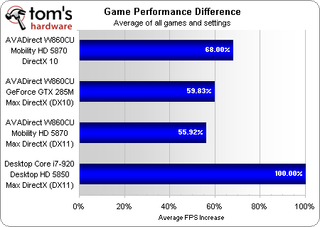AVADirect's W860CU: Mobility Radeon HD 5870 Vs. GeForce GTX 285M
Custom system builder AVADirect is one of the few companies to offer the flexibility of multiple graphics modules within the same notebook model. We used its high-end W860CU to compare AMD's and Nvidia's highest-performance mobile graphics processors.
Conclusion
Planned long before the hardware was ready, today’s article was intended to highlight the performance advances of AMD's latest mobile graphics processor. In that vein, let’s begin the final analysis with a game-performance summary.

The Mobility Radeon HD 5870 device wins as expected, trumping the G92-based GeForce GTX 285M by over 8% when using the G92's older DirectX limitation. Congratulations go to AMD for beating what is essentially an efficiency-enhanced GeForce 8800 GTS 512MB, but AMD's new mobile flagship still looks strangely weak when compared to the "lower model" desktop part. It might make sense for an underclocked version of the Radeon HD 5770 to have 56% of the Radeon HD 5850’s performance, but we weren't expecting the Mobility Radeon HD 5870 to be an underclocked Radeon HD 5770 when it was announced last winter.
The Mobility Radeon HD 5870 handily outpaces the GeForce GTX 285M's older architecture, but that should be possible even with a modern $150 desktop card. A $150 desktop card’s GPU and RAM are what mainly compose the $400 Mobility Radeon HD 5870. If we thought Nvidia’s naming scheme was a scam, what more can we say when AMD follows the same path?
AVADirect's Contribution
The notebooks we tested today are state-of-the-art, with unsurpassed build quality backed by an assembly firm with a solid reputation. It’s not really fair for AVADirect, which set us up with the latest technology, to take any abuse on behalf of AMD and Nvidia, and so we’d like to take a minute to express our sincerest gratitude to the builder for allowing us the opportunity to compare these mobile graphics architectures using its well-built systems. These two configurations are the pinnacle of notebook graphics technology, so the only question left for us to answer is what buyers who think they need more should do.
As it stands, buyers who need something more powerful than what a GeForce 8800 GTS or Radeon HD 5770 can deliver are forced to reconsider desktop PC form factors. It’s nice to know that AVADirect is just as expert at configuring those, but anyone whose portability needs are at odds with their performance needs must put some serious thought into compromising at least one of those two competing goals.
Stay on the Cutting Edge
Join the experts who read Tom's Hardware for the inside track on enthusiast PC tech news — and have for over 25 years. We'll send breaking news and in-depth reviews of CPUs, GPUs, AI, maker hardware and more straight to your inbox.
-
ta152h I'm a little confused why you'd choose an i7 920 to compare with a different platform, but maybe it's because I don't know the mobile platform that well.Reply
But, if it's like the P55, which it seems to be, there's the added uncertainty of the architecture thrown in.
Particularly with PCI-E being implemented differently, you might be seeing the inferior implementation of the P55 architecture responsible for a small amount of the relatively poor mobile performance. Since this implementation needs to multiplex the memory bus of the processor, you can run into situations where there is contention.
I doubt it's significant, but I'm curious why you wouldn't want to make a comparison with a more similar desktop platform. Was it because you couldn't get an unlocked Lynnfield to get the clock speeds for the processors the same in Turbo mode?
-
This doesn't make much sense to me... if a 5870M chip = roughly a 5770 desktop chip and a 285M = roughly an 8800gts.. why is it not completely spanking it? we all know 5770>8800.. by a rather large margin! what could be the cause of this?Reply
-
anamaniac Tom's, you should show your power usage results to AMD and ask for an explanation, on why a lower rated part is using more power.Reply
Granted, with a 45W CPU and 50W GPU, 30 mins is expected on a 40W battery if fully stressed. -
jkeopka I liked this article because I found it so darn relevant... I actually have this same Clevo Laptop, with the 5870 and 8 gigs of RAM.Reply
The GTX 285M was a $50 premium over the 5870, and I am glad I chose to stick to the 5870. It is kind of strange one would pay more to have less performance. I guess thats what fanboyism are all about? -
jkeopka anamaniacHow many partners use Clevo laptops and just rebrand them?Lots. Mine is a Sager 8690... which is a rebranded Clevo W860CU...Reply
I have seen this model at other sites as well. -
falchard Looks more like a bottleneck then anything conclusive. The results in nearly all the tests were close, yet 1 of them should have been clearly ahead.Reply
I think an ASUS JH73-A1 verse this would have been more interesting as its a bit cheaper for better parts. -
Crashman TA152HI'm a little confused why you'd choose an i7 920 to compare with a different platformSame speeds in Turbo mode, which is used during games, the primary focus being gaming performance.TA152HBut, if it's like the P55, which it seems to be, there's the added uncertainty of the architecture thrown in.That's true, but neither graphics solution provided the performance needed to highlight the mobile processor's on-die PCIe controller's performance advantage.TA152HI'm curious why you wouldn't want to make a comparison with a more similar desktop platform. Was it because you couldn't get an unlocked Lynnfield to get the clock speeds for the processors the same in Turbo mode? Exactly. Besides, Tom's Hardware has already seen that clock-for-clock, Lynfield games at least as well as Bloomfield when a single card is used. If nothing else, the comparison favors the mobile solution's lower power consumption.Reply
Most Popular



